How wearable technology is used in construction
28 July 2021
Andy Brown explores how advancements in wearable technology are transforming the sector as companies get more cautious about health and safety courtesy of smart devices.
One of the key considerations for everyone working in construction is safety, and standards across the industry have generally improved immensely over recent years. Can you imagine workers sitting atop a half-built skyscraper, dangling their legs off the side with no safety equipment like the iconic 1932 photo Lunch atop a Skyscraper during the construction of the Rockefeller Center in New York?
Standards may have improved vastly, yet they vary considerably across the globe. Good news for the construction industry is that wearable technology has the potential to transform safety standards in the sector on top of of improving efficiency and productivity. There are innovations such as exoskeletons, emergency alerts, smart GPS-enabled wearables and smart personal protective equipment (PPE).
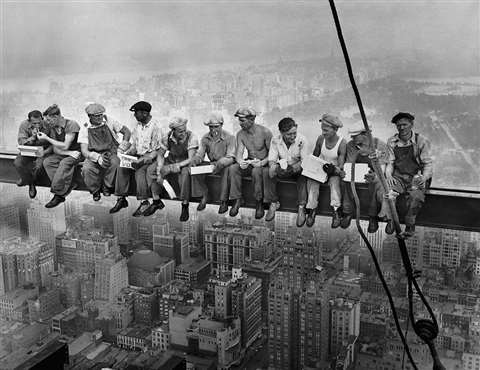 Eleven men enjoying lunch on a girder in a 1932 promotional photo for the new skyscraper at the Rockefeller Center, New York
Eleven men enjoying lunch on a girder in a 1932 promotional photo for the new skyscraper at the Rockefeller Center, New York
The wearable technology industry was worth nearly US$23 billion in 2018 and is expected to grow at a compound annual growth rate of 19% to reach US$54 billion by 2023, according to a report from London-based GlobalData.
Danny Richards, lead economist at GlobalData, said, “Wearable tech, like the smart helmets developed by companies such as SmartCap Technologies, is helping to increase safety on construction sites.
“Despite wearables’ difficulty launching in the consumer market, its commercial applications have proven valuable. As the benefits of wearable tech becomes clearer to construction companies, uptake is likely to increase.”
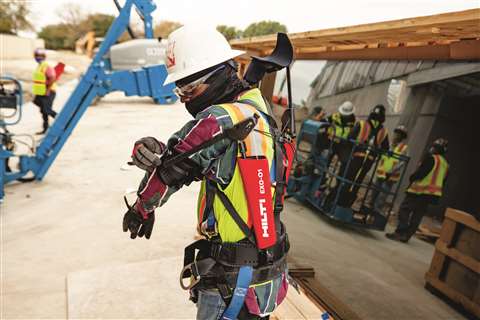 Exoskeleton taps into mega trends, such as the lack of skilled workers and health & safety
Exoskeleton taps into mega trends, such as the lack of skilled workers and health & safety
Exoskeletons for construction workers
Another key factor likely to add to the growth of this sector is the ageing workforce in many countries. For instance, wearable exoskeletons can be used as an aid for workers’ physical support during strenuous tasks where there is a risk of injury.
One of the companies leading the way regarding exoskeletons in construction is Hilti – a Liechtenstein-headquartered multinational company that develops, manufactures and markets products for the construction, building maintenance, energy and manufacturing industries.
 Johannes Huber believes, “Exoskeletons and related solutions will see increasing relevance and acceptance”
Johannes Huber believes, “Exoskeletons and related solutions will see increasing relevance and acceptance”
Johannes Huber, head of Hilti’s Business Unit Diamond, reveals that due to the newness of the product they decided on a gradual rollout, which started in Sweden in 2020 followed by Europe and more recently across the United States.
Huber explained, “Customers really like Hilti’s exoskeleton. This represents the first time something like this has been introduced in the construction industry.
“The positive feedback from our customers includes the benefit of the EXO-O1 in terms of health & safety as well as in productivity, especially when performing physically demanding overhead tasks.”
While any unfamiliar product takes time to be accepted, Huber said that the exoskeleton is very relevant as it taps into megatrends.
Huber added, “We are convinced that the field of exoskeletons and related solutions will see increasing relevance and acceptance.
“Such solutions address several megatrends in the construction industry, such as the lack of skilled labour, an increasing awareness of health & safety and a need for productivity.”
Another key aspect of wearable technology are products that enable workers to harness the ongoing digitisation of the construction industry through mixed reality (MR) – the blending of what is actually there with augmented reality (AR) and virtual reality (VR). This occurs in real time and helps users efficiently interpret digital and physical information, as well as the spatial relations between them.
Mixed reality for construction
For example, US-headquartered Trimble – whose industrial technology solutions connect the physical and digital worlds – has been transforming the way that the world works to bring HoloLens technology to teams by using a MR solution to visualise designs and drawings in 3D while on the jobsite, which improves a company’s pre-planning process and workflow.
Jordan Lawver, senior business area manager for AR/MR/VR at Trimble, explained, “Mixed reality has crossed the chasm from the days of early adoption and testing a few years ago to now being an integral part of the connected construction workflow, so continued growth is expected.
“Demand has outpaced our original expectations and only solidified our belief that mixed reality is here to stay as a fundamental tool for construction.
“We have seen interest from all around the world. With the most advanced deployments coming from those regions, such as North America and Scandinavia, where BIM and construction technology adoption is high.”
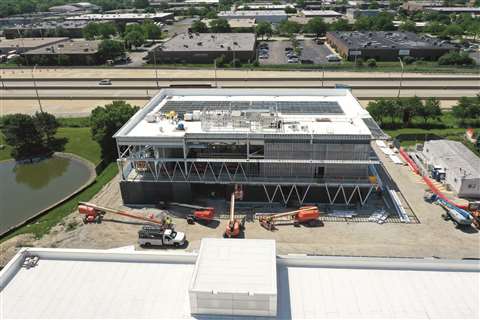 Drone image from Oracle Innovation Lab, which tests a whole host of new construction technology
Drone image from Oracle Innovation Lab, which tests a whole host of new construction technology
Wearable tech will boost staff safety and wellness
Located just outside the US city of Chicago is a facility that that provides owners and contractors with a simulated worksite environment where they can have hands-on experiences with new technology, such as wearables.
The Oracle Innovation Lab tests all kinds of technology as a simulated worksite, which includes demonstrating the transformative power of the Internet of Things (IoT), autonomous equipment, artificial intelligence (AI) and drones.
 Dr. Burcin Kaplanoglu reiterated, “Safety is the no.1 benefit that smart wearables can provide to a jobsite”
Dr. Burcin Kaplanoglu reiterated, “Safety is the no.1 benefit that smart wearables can provide to a jobsite”
Dr Burcin Kaplanoglu, vice president with Oracle Industries Innovation Lab, claims that wearables are fast becoming an essential piece of equipment.
He stated, “Safety is the no.1 concern on a construction site. Smart wearables are already becoming an essential piece of equipment, aimed at improving worker safety, health and productivity.
“As the construction industry continues its digitisation journey, so does its rapid adoption of wearables. This includes smart work boots, hard hats, gloves and safety goggles, as well as smart equipment that is compatible with larger IoT and 5G networks.”
Jennifer Stiansen, director of marketing Americas at JLG Industries, one of the world’s biggest manufacturers of access equipment agrees that wearables will be an increasingly common sight.
She enthused. “Technology is advancing at an astounding rate. Wearables will be more commonplace on jobsites to provide valuable data on employee health & safety and operations, which will lead to more efficient job sites.”
JLG partnered with technology company Kinetic during the Covid-19 pandemic to foster a safe environment for its workforce by piloting a new feature on the company’s Reflex device at one of JLG’s US-based factories. Kinetic provides wearable technology and a software analytics platform that helps reduce workplace injuries and protects workers from Covid-19.
The company had been using Kinetic’s Reflex device prior to Covid to provide team members with instant feedback on high-risk ergonomic postures to reduce the number of high-risk movements.
Stiansen added, “When Covid-19 hit, the new feature being piloted helped advance our ‘Safe at Six’ practices. Manufacturing floor team members were asked to wear the devices at the start of their shift to gain instant feedback via a buzz when they came within six feet of another worker.
“The Kinetic device simply attached to their belt or pants, and it was turned in at the end of their shift. The devices provided the ability to contact trace in the event an employee could have potentially been exposed to Covid-19 during their work day.”
Wearable technology and Covid-19
There is no doubt that the pandemic problem has accelerated the adoption of new technology. Wearables appear high on the wish list of many businesses, especially given its ability to help track workers and to promote social distancing.
Global contractor Jacobs has produced a tool, named ion, which captures and analyses data from a host of different sources such as wearable wristbands and mobile apps.
Prior to the outbreak of Covid-19 it was primarily being used at petrochemical facilities. They adapted it to be deployed across construction when it became clear that there was the increased need for contact tracing and location tracking,
Micah Krider, ion project manager at Jacobs, explained, “The technology is interchangeable and scalable. It can be tailored, based on the application use to address critical safety, security, accountability, compliance and performance monitoring and workflow optimisation needs.
“The solution is enabling greater efficiency and safety through automated and contactless solutions for monitoring occupancy and facilitating contact tracing.
“We believe there are applications for safety and efficiency even after the pandemic as ion is proven to deliver a 70 per cent reduction in hazardous incident response time through accurate, real-time information, a 25% increase in productivity and 30 to 40% reduction in maintenance costs.”
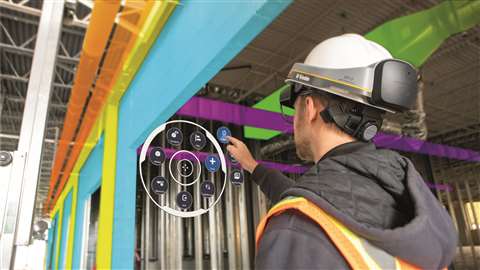 The Trimble XR10 for HoloLens 2 opens up new possibilities by offering the ability to visualise the progress of projects
The Trimble XR10 for HoloLens 2 opens up new possibilities by offering the ability to visualise the progress of projects
Surge of smart devices in global construction sector
Lawver, said, “Trimble XR10 with HoloLens 2 technology helped the construction industry overcome the Covid-19 travel restrictions by giving clients the ability to visualise the progress of their project, and to align with all stakeholders on any design adjustments or changes from remote locations.
“The pandemic made it very clear how investments in technology can serve to make construction firms more robust in times of uncertainty. Now it has done a 180 and the construction industry is in one of the biggest booms in history, causing even more construction companies to look for ways to keep up and become more productive. Both have increased technology adoption considerably.”
The pandemic has created opportunities for wearable technology through social distancing rules. Yet one of the biggest drivers behind its growth will remain long after Covid-19 is a memory – worker safety. Safety standards are increasing and those in the wearable technology business can tap into this trend.
US-based Triax Technologies, a partner with Oracle, is showcasing its Spot-r Clip at the Innovation Lab. It is their flagship, wearable device that is attached to belts or hard hats, which can alert construction companies if a worker falls.
Kaplanoglu explained, “Safety is the no.1 benefit that smart wearables can provide to a jobsite.
“They are already an essential piece of equipment aimed at improving worker safety, health and productivity. By adding new technology to existing safety gear, wearables can help monitor vital signs, detect collisions and track unaccompanied workers.”
It is also worth noting, as the trend for increased worker standards and safety continues to improve, so does the technology. Trimble’s Lawver notes that technology is getting cheaper, lighter, and generally more accessible and usable for all.
Lawver concluded, “As this happens it will become weaved into every part of our day, just as the phone has, regardless of if we’re at home or at work. For the construction worker it will be an indispensable tool that helps guide their work and keep them safe on the site.”
It may be a while yet before smart wearable technology becomes as widespread as mobile phones are now, but these advancements will prove pivotal to future success of the construction sector and the welfare of their employees.
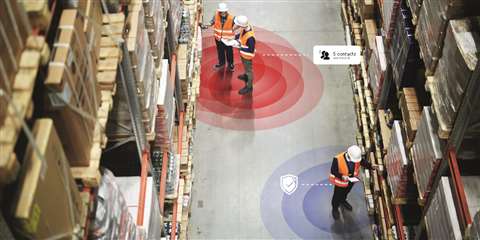 JLG Industries has used Kinetic wearable tech to reduce risk during the Covid-19 pandemic
JLG Industries has used Kinetic wearable tech to reduce risk during the Covid-19 pandemic
STAY CONNECTED



Receive the information you need when you need it through our world-leading magazines, newsletters and daily briefings.
CONNECT WITH THE TEAM








